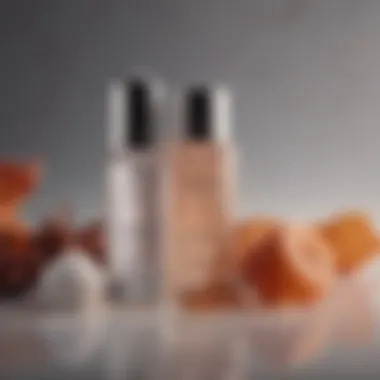Revitalize Dry Aging Skin: Essential Care Tips


Intro
Aging brings its own set of challenges, and one of the most prominent is dry skin. As we age, skin loses moisture and elasticity, leading to a dull appearance and increased wrinkles. Understanding the relationship between age and skin dryness is crucial for developing effective skin care regimens. This article aims to guide readers in their quest for healthier, more hydrated skin by examining essential factors and practical solutions.
Fashion Trends
In the realm of skincare, knowing the latest trends can enhance your routine significantly. While fashion trends often revolve around clothing styles, the concept extends to skin care. The goal is to achieve skin that radiates health.
Key Focus Areas
- Sustainable Ingredients: Natural and organic components have become popular. They are gentler on aging skin and provide the nutrients it needs without harsh chemicals. Look for products containing hyaluronic acid, glycerin, and ceramides.
- Glow-Enhancing Treatments: Treatments that revitalize and hydrate the skin are trending. These include treatments with Vitamin C and retinol, which have shown to improve skin texture and tone.
"Proper hydration is not just a trend, but a necessity for maintaining youthful skin."
Routine Innovations
- Layering Techniques: Many beauty enthusiasts are now adopting the layering method. Applying products in the correct order ensures that each layer penetrates effectively.
- Adaptability: Personalizing your routine based on seasonal changes can make a substantial difference in combating dryness.
Beauty Tips and Tricks
The beauty industry never stops evolving. Hence, knowing the effective practical tips is essential to navigate the complexities of aging skin.
Skincare Regimens
Creating a routine that works for dry aging skin is vital. Start with a gentle cleanser, followed by a hydrating toner. Next, incorporate serums with active ingredients before moving to moisturizers.
Makeup Essentials
Makeup can emphasize dry skin if not chosen wisely. Opt for liquid foundations with hydration rather than powder formulations. Always finish with a hydrating setting spray to lock in moisture.
Hair Care Focus
Many overlook hair care within the beauty regime for aging skin. A hydrating mask for your hair can parallel your skincare efforts, preventing a dry and brittle appearance.
Ending
The journey to achieving hydrated skin is more intricate than it seems. Understanding trends and effective methods is essential. This guide covers not only skincare products but also sheds light on routines tailored for dry aging skin. By employing these strategies, readers can maintain youthful and radiant skin as they age. Following the steps detailed here is a proactive approach to skin health, ensuring comprehensive care that evolves with your skin.
Understanding Dry Aging Skin
The concept of dry aging skin is critical when discussing skin care for mature individuals. As people age, their skin undergoes various changes that can lead to increased dryness and the appearance of fine lines and wrinkles. Recognizing these changes is vital for selecting appropriate skin care products and routines.
Defining Dry Skin
Dry skin, clinically known as "xerosis," occurs when the skin loses moisture and fails to retain hydration. This condition can result from environmental factors, genetic predisposition, or lifestyle choices. Characteristics of dry skin include roughness, tightness, and flakiness. Understanding these traits is essential because they help identify the specific needs of an individual’s skin.
Why Skin Dries Out with Age
Various factors contribute to the dryness associated with aging skin. As individuals grow older, skin naturally produces less sebum, which is the body's natural oil. This decline in oil production leads to decreased moisture retention. Additionally, the skin's ability to regenerate itself diminishes, causing a slower turnover of skin cells. Hormonal changes, particularly during menopause, can further exacerbate skin dryness. Understanding these mechanisms aids in the development of effective strategies targeting the underlying causes of dryness.
Identifying the Signs of Aging
Recognizing the signs of aging is crucial for implementing timely interventions. Common indicators include:
- Fine lines and wrinkles: These often appear around the eyes and mouth as skin loses elasticity.
- Sagging skin: Loss of collagen and elastin can give the skin a lax appearance.
- Rough texture: Dry skin often feels coarse or uneven.
- Age spots: Hyperpigmentation can emerge, particularly on sun-exposed areas.
Being aware of these signs allows individuals to choose products that not only hydrate but also support skin's overall health and appearance.
Proper awareness and understanding of dry aging skin lead to better skincare choices and outcomes.
The Importance of Hydration
Hydration serves as a cornerstone for maintaining the health and vitality of dry aging skin. As skin matures, its natural moisture retention diminishes. This is evident in the increased occurrence of flaky patches, enhanced roughness, and a diminished glow. Understanding the role of hydration is essential for anyone managing dry skin, particularly as one ages. Without adequate water content, skin can appear dull and more susceptible to signs of aging.
Water Intake and Skin Health
The influence of water intake on skin health is profound. Hydration starts from within; drinking sufficient water daily contributes to overall skin elasticity and health. When the body is hydrated, the dermal layers can function efficiently, leading to a more plump appearance.
Benefits of adequate water consumption include:


- Improved skin elasticity
- Enhanced circulation
- Delivery of nutrients to skin cells
Aiming for eight glasses a day is a common guideline, but individual needs may vary based on factors such as activity level and climate. Adopting an awareness of hydration not only helps the skin but boosts overall health as well.
Moisturizing: A Fundamental Step
Moisturizing is vital for addressing the needs of dry aging skin. This process replenishes moisture levels and creates a barrier to prevent further loss. A well-formulated moisturizer provides hydrating elements and locks them into the skin, reducing the appearance of fine lines and dryness.
It's important to apply moisturizer while skin is damp, as this helps in maximizing absorption. Moreover, incorporating a moisturizer into daily skincare routines becomes a non-negotiable step, particularly in fighting the effects of aging.
Choosing the Right Moisturizer
The choice of moisturizer can significantly impact the effectiveness of a skincare regimen. Two major categories dominate the market: gels and creams.
Gel vs. Cream
Gels are lightweight and absorb quickly into the skin. They are an excellent option for those who prefer a refreshing finish. Creams, on the other hand, are typically richer and provide a more intensive hydration experience. The choice between the two depends largely on personal preference and skin type.
Key distinctions can include:
- Gels
- Creams
- Lightweight feel
- Ideal for oily or combination skin
- Less likely to clog pores
- Richer texture
- Best for very dry or sensitive skin
- Provides longer-lasting hydration
Both options have their advantages and disadvantages, but mixing them based on seasonal or skin condition changes can yield better results.
Natural Ingredients vs. Synthetic
The debate between natural and synthetic ingredients in moisturizers often arises. Natural ingredients are derived from plant sources and can contain beneficial compounds such as vitamins and antioxidants. They are often perceived as less irritating and more suitable for sensitive skin.
However, synthetic ingredients can offer stability and a longer shelf life. They might also have improved delivery systems for active components.
Factors to consider include:
- Natural Ingredients
- Synthetic Ingredients
- Generally gentler on the skin
- Sustainable options available
- Potential for allergic reactions to certain botanicals
- Controlled formulation
- Known concentrations of actives
- May irritate sensitive skin
Ultimately, the choice hinges on individual preferences, skin sensitivities, and desired outcomes.
Proper hydration and thoughtful skincare choices can significantly improve the appearance and health of dry aging skin.
Key Ingredients for Dry Aging Skin
The significance of incorporating key ingredients in skin care for dry aging skin cannot be understated. As skin matures, it loses its natural moisture and elasticity, which contributes to dryness and the visibility of fine lines and wrinkles. The right active ingredients can help mitigate these effects by enhancing hydration, restoring skin barrier function, and promoting cell turnover. Understanding these ingredients and their specific benefits allows for more informed decisions when selecting skin care products.
Hyaluronic Acid
Hyaluronic acid is a naturally occurring substance in the body, known for its remarkable ability to retain moisture. This key ingredient can hold over a thousand times its weight in water, making it essential for keeping skin plump and hydrated. When applied topically, hyaluronic acid draws water into the outer layer of the skin, providing immediate hydration.
Using products containing hyaluronic acid can significantly improve the appearance of dry aging skin. It can help reduce the appearance of fine lines by adding volume and smoothing texture. Products like serums and moisturizers enriched with this ingredient should be considered fundamental in any skin care routine aimed at combating dryness.
Ceramides
Ceramides are lipids that play a crucial role in maintaining the skin's barrier. They help prevent moisture loss and protect against environmental stressors. This is particularly important for aging skin, which may struggle to retain moisture due to a weakened barrier. Incorporating ceramides into skin care products can help restore hydration levels and improve the skin’s overall appearance.
The use of ceramide-rich creams or oils can effectively seal in hydration and reinforce the skin barrier. This helps in countering the dryness associated with aging and can lead to visibly smoother and more resilient skin.
Peptides
Peptides are short chains of amino acids that serve as building blocks for proteins like collagen and elastin. These proteins are essential for maintaining skin firmness and elasticity. With age, the natural production of collagen declines, contributing to sagging skin and the formation of wrinkles.
By applying peptide-infused products, such as serums or creams, one can promote collagen synthesis, enhancing the skin's structure and resilience. Regular use of peptides can lead to a firmer, more youthful appearance, making them a valuable addition for anyone dealing with dry aging skin.
Antioxidants


Antioxidants are critical in protecting the skin from oxidative stress caused by free radicals. These free radicals can contribute to premature aging and skin dryness. Common antioxidants include vitamins C and E, which not only protect the skin but also help in repairing damage and promoting a more even skin tone.
Utilizing products rich in antioxidants can help combat the signs of aging, reduce inflammation, and improve hydration. A daily application of these ingredients can support the skin's natural renewal process, fostering a more vibrant appearance over time.
Retinol and Retinoids
Retinol and retinoids are derivatives of vitamin A, known for their powerful anti-aging properties. These ingredients promote cell turnover and stimulate collagen production, addressing issues such as fine lines, wrinkles, and uneven skin tone. While retinol is available in over-the-counter products, retinoids are often prescribed for more significant concerns.
Individuals with dry skin should approach retinol cautiously, as it can be irritating. However, when used correctly, these compounds can transform the appearance of aging skin by improving texture and increasing hydration levels. Gradual incorporation into one’s routine, often starting with lower concentrations, can lead to long-lasting benefits.
"Incorporating the right key ingredients is essential for rejuvenating and hydrating aging skin, making informed choices paramount."
Understanding these key ingredients can significantly enhance the effectiveness of a skin care routine designed for dry aging skin. They each serve specific roles that collectively contribute to healthier, more youthful skin. Making knowledgeable selections based on individual needs can result in palpable improvements in skin health and appearance.
Establishing a Skin Care Routine
Establishing a proper skin care routine is critical for those dealing with dry aging skin. A consistent and well-planned regimen can significantly improve overall skin appearance and health. This routine not only addresses hydration but also creates a protective barrier against environmental stressors. Setting a routine helps penetrate the skin with essential nutrients, amplifying the effectiveness of products used.
Adapting a skin care routine involves several key considerations. First, the choice of products plays a crucial role. Ingredients must be tailored to meet the specific needs of dry, aging skin using effective technologies. Furthermore, the order in which products are applied can affect their absorption and efficacy. Incorporating the right steps ensures that each application complements the other.
Cleansing: Finding the Balance
Choosing Gentle Cleansers
Cleansing the skin is the initial step in any skin care routine. For individuals experiencing dry aging skin, choosing gentle cleansers becomes essential. A gentle cleanser respects the skin's natural barrier without stripping it of necessary oils.
The key characteristic of gentle cleansers is their ability to cleanse without causing irritation. This makes them a beneficial choice for this article as they cater specifically to delicate skin types. Gentle cleansers typically feature moisturizing ingredients, which provide hydration and help maintain skin's integrity.
One notable advantage of gentle cleansers is their inclusivity for sensitive skin types. They can significantly reduce the risk of adverse reactions that harsher cleansers may provoke, leading to redness or inflammation. However, it's essential to ensure that these products sufficiently remove impurities and make-up without leaving residue.
Frequency of Cleansing
Frequency of cleansing is another important aspect of maintaining skin health. Generally, it is recommended to cleanse the face twice daily, in the morning and evening. For those with dry aging skin, this frequency allows for the removal of pollutants and excess oils while providing a mild, refreshing feel.
The key characteristic of this cleansing frequency lies in its balance. Regular cleansing helps to prevent the build-up of dead skin cells and debris, thus supporting a healthier skin surface. Furthermore, a consistent routine encourages better absorption of subsequent products.
A unique feature of cleansing twice daily is that it sets the stage for hydration that follows. If cleansing is done too infrequently, there may be an accumulation of skin concerns that can result in an uneven complexion or dullness. On the downside, over-cleansing can lead to irritation, so finding a personal balance is crucial.
Exfoliation Strategies for Mature Skin
Chemical Exfoliants vs. Physical Exfoliants
Exfoliation is a vital step in care for dry aging skin. It helps remove dead skin cells, promoting healthier skin renewal. Both chemical and physical exfoliants offer unique benefits and should be selected based on individual skin needs.
The key characteristic of chemical exfoliants is their ability to penetrate the skin to dissolve dead cells without friction. This option is often preferred for those with sensitive skin or conditions like rosacea. On the contrary, physical exfoliants offer a more immediate feel through tangible scrubbing, which may appeal to some users.
The unique feature of chemical exfoliants is their suitability for more frequent use. They can fit seamlessly into a regular routine, even when dealing with dry skin issues. However, users must be cautious not to overuse either type, as excessive exfoliation can lead to more dryness or sensitivity.
How Often to Exfoliate
How often one should exfoliate varies depending on skin type and product choice. For dry aging skin, exfoliation is typically recommended once or twice a week. This routine helps avoid excessive removal of skin layers and maintains a healthy barrier.
The key characteristic of this recommended frequency is its balanced approach to skin care. By not over-exfoliating, the skin retains its natural moisture while still benefiting from improved texture and tone.
A unique aspect of this frequency is how it allows the skin to recover between sessions. Any signs of irritation or excessive sensitivity should prompt a reevaluation. Adjusting the exfoliation schedule based on skin's reactions ensures that care remains effective and supportive.
Serums and Treatment Applications
Serums play an essential role in targeting specific concerns. They contain concentrated active ingredients that treat various issues like dehydration, fine lines, and pigmentation. This makes serums valuable for boosting the overall health of dry aging skin. Regular application can enhance the results of the entire routine and work alongside other products to maximize effectiveness.
Sun Protection: An Ongoing Necessity
Sun protection is a crucial aspect that cannot be overlooked. Prolonged sun exposure can lead to further aging and drying of skin due to UV damage. Using a broad-spectrum sunscreen daily is recommended, even on cloudy days. This proactive measure guards against photodamage, allowing skin to maintain its vitality and youthful appearance. Regular application also aids in the effectiveness of any other skin treatments being utilized, leading to lasting results.
Professional Treatments to Consider
Professional treatments play a crucial role in managing dry aging skin, offering advanced solutions that go beyond standard home care. These treatments can enhance the appearance of your skin and address specific concerns related to aging, dryness, and texture. Integrating professional approaches can rejuvenate the skin’s health while providing a targeted method of care.
Dermatological Consultations


Consulting a dermatologist is often the first step for those seeking to improve their skin condition. Dermatologists specialize in skin health and can assess your individual skin needs. They can recommend personalized treatment plans based on specific factors such as skin type, age, and underlying conditions.
Benefits of a dermatological consultation include:
- Customized Solutions: Tailored advice that factors in your unique skin characteristics.
- Medical Treatments: Access to prescription-strength products that can be more effective than over-the-counter options.
- Skin Condition Diagnosis: Identification of any underlying skin issues such as eczema or psoriasis.
A dermatologist can also guide you on integrating effective over-the-counter products that suit your skin's needs and can monitor your progress over time.
Hydrating Facials and Peels
Hydrating facials are designed to provide deep moisture and nourishment to dry skin. They often incorporate specialized ingredients aimed at restoring hydration levels. During these treatments, a trained professional applies products that contain elements like hyaluronic acid and glycerin, which can draw moisture into the skin and improve texture.
Peels, on the other hand, can exfoliate the skin using alpha-hydroxy acids or other exfoliants. This process can enhance water absorption in the skin and promote a youthful glow. Here are some points to consider:
- Instant Results: Most hydrating facials provide immediate moisture, making the skin look plumper and healthier.
- Improved Texture: Regular treatments can enhance the skin's surface, making it smoother and more radiant.
- Long-Term Benefits: Both facials and peels can stimulate collagen production over time, contributing to firmer skin.
Injectables: Botox and Fillers
Injectables represent another category of professional treatments that target aging symptoms in the skin. Botox works by temporarily paralyzing the muscles that cause wrinkles, leading to a smoother look.
Fillers, such as Juvederm or Restylane, directly add volume to areas where age-related volume loss is visible. They can fill in wrinkles and enhance facial contours. Consider the following aspects:
- Immediate Results: Both treatments can provide noticeable changes quickly, often within a day or two.
- Longevity: Effects from Botox typically last three to six months, while fillers can last from six months to two years, depending on the type used.
- Expert Administration: It's essential to have these procedures done by licensed professionals to achieve the best results and minimize risks.
"The effectiveness of injectables lies in their ability to deliver results without extensive downtime, providing a quick remedy for aging skin symptoms."
Lifestyle Factors Affecting Skin Health
Understanding how lifestyle factors influence skin health is crucial for anyone looking to maintain a youthful appearance, especially those dealing with dry aging skin. Various elements such as diet, stress management, and sleep quality play significant roles in skin condition. By comprehensively analyzing these factors, individuals can implement effective strategies to enhance their skin's hydration and overall health.
Dietary Influence on Skin Condition
The link between diet and skin health cannot be overstated. What we eat directly affects our skin’s hydration levels and texture. Vitamins and minerals found in fruits and vegetables greatly benefit the skin. For instance, Vitamin C is essential for collagen production, while Omega-3 fatty acids, found in fish like salmon, help maintain skin barrier function and combat dryness.
Additionally, antioxidants play a key role in fighting free radicals that cause skin damage. Regular consumption of foods rich in antioxidants, like blueberries and spinach, may enhance skin resilience.
It's advisable to limit sugar intake as it can lead to glycation, a process that damages collagen and elastin, leading to premature aging. Instead, focus on a balanced diet, incorporating plenty of water-rich foods like cucumbers and watermelon, which can contribute to overall skin hydration.
Stress Management and Skin
Stress can have a detrimental impact on skin health. When under stress, the body produces more cortisol, which can lead to increased oil production and potential breakouts. Alternatively, chronic stress can result in skin conditions such as eczema and psoriasis, worsening dryness and irritation.
Implementing effective stress management techniques is vital. Regular exercise not only improves physical health but also promotes the release of positive hormones that can improve skin. Activities like yoga and meditation can also help reduce stress levels, potentially resulting in clearer and healthier skin.
Furthermore, engaging in hobbies or activities that one enjoys can significantly lower stress levels, translating to better skin condition. Finding ways to unwind daily can be an essential part of a skin health regimen.
Sleep Quantity and Quality
The importance of sleep for skin health is significant. Adequate sleep allows the body to repair skin and regenerate cells. A consistent sleep schedule contributes to decreased dark circles and overall skin tone improvement. While we sleep, the skin undergoes essential reparative processes, including collagen production, which is crucial for maintaining elasticity and hydration as we age.
Sleep deprivation often manifests as dull skin and enhanced signs of aging. Establishing a bedtime routine can enhance sleep quality. Techniques like creating a calming environment and limiting screen time before bed can significantly improve how well someone sleeps.
"Sleep is the best meditation." – Dalai Lama
To conclude, understanding the impact of dietary choices, stress management practices, and sleep hygiene is vital when addressing dry aging skin. A holistic approach that combines these lifestyle factors can create a synergistic effect, ultimately leading to healthier, more hydrated skin.
Common Concerns and Misconceptions
Common concerns and misconceptions about skin care, particularly for dry aging skin, can greatly influence how individuals approach their routines. Addressing these issues is crucial as it enables a clearer understanding of effective skin care practices. Many people hold preconceived notions, often based on outdated information or marketing ploys. By clarifying these misconceptions, readers can make informed decisions that genuinely benefit their skin.
Is Oily Skin Better Than Dry?
A prevalent belief is that oily skin is inherently better than dry skin. This misconception stems from the assumption that oiliness equates to youthful skin. In reality, both oily and dry skin types have their respective advantages and disadvantages.
Oily skin tends to retain moisture better, as sebum can create a protective barrier. This can lead to fewer visible signs of aging, such as fine lines and wrinkles. However, oily skin can also result in enlarged pores and an increased risk of acne.
On the other hand, dry skin may show aging signs more quickly due to a lack of natural oils. Individuals with dry skin often face issues like flakiness and irritation. Yet, recognizing that dry skin can be managed effectively with the right products is vital. Quality moisturizers and serums can counteract dryness and maintain skin elasticity without compromising on overall skin health. Therefore, the idea that one skin type is superior to another is simply misleading.
Myths about Anti-Aging Products
Another area rife with misconceptions is regarding anti-aging products. Many consumers believe that all anti-aging products provide miraculous results or instant transformations. This notion is misleading and can result in disappointment.
Firstly, anti-aging products often take time to show noticeable effects. Ingredients such as retinol or hyaluronic acid may require several weeks of consistent use before results become visible. Moreover, the effectiveness of these products can vary widely between individuals. Factors such as skin type, lifestyle choices, and even dietary habits influence how skin responds to treatment.
Furthermore, some people think that high-priced products are automatically more effective. Price does not necessarily equate to quality. Many affordable brands offer effective solutions, while high-end products might not deliver the promised results. Choosing products based on ingredients and personal skin concerns rather than price or brand reputation is essential.
"Understanding the truth behind common skin care myths can pave the way for more effective routines and healthier skin."















